小学英语作业设计案例
小学英语有效作业设计案例分析

小学英语有效作业设计案例分析简介本文旨在分析小学英语有效作业的设计案例,并探讨这些设计案例的有效性及其带来的教育效果。
案例一:单词卡片练设计目的通过制作和使用单词卡片,帮助学生记忆和掌握英语单词。
设计内容学生需要根据教材中的单词,自行制作单词卡片,并在家里进行翻阅和复。
教育效果这种作业设计能够锻炼学生的自主研究能力,让他们在课堂外自觉地进行单词复。
通过反复翻阅卡片,学生能够加深对单词的记忆,并提高其词汇量。
案例二:听力练设计目的通过听力训练提高学生的英语听力水平。
设计内容学生需要在家中进行听力练。
教师会提供一段英语录音并准备相应的听力练题目,学生需要听录音并回答问题。
教育效果听力是语言能力的重要组成部分,这种作业设计能够提高学生的听力理解能力。
同时,学生可以在家庭环境中进行练,减少了课堂上的干扰,提高了研究效果。
案例三:口语对话练设计目的通过口语对话练,提高学生的英语口语表达能力。
设计内容学生需要与同学进行英语口语对话练。
教师会提供对话题目和相关词汇,学生需要自行组织对话并进行实践。
教育效果口语是语言交际的重要方面,这种作业设计能够培养学生的口语表达能力,提高他们在实际场景中的交流能力。
通过与同学进行对话练,学生能够互相纠正错误,提高语言准确性。
结论有效的英语作业设计应能激发学生的主动性和学习兴趣,并通过实践提高他们的语言能力。
单词卡片练习、听力练习和口语对话练习是几个有效的作业设计案例,能够帮助学生在家庭环境中提高英语学习效果。
教师在设计作业时应注重培养学生的自主学习能力,并将作业内容与学生的实际需求和兴趣相结合,从而达到更好的教育效果。
小学英语作业设计案例
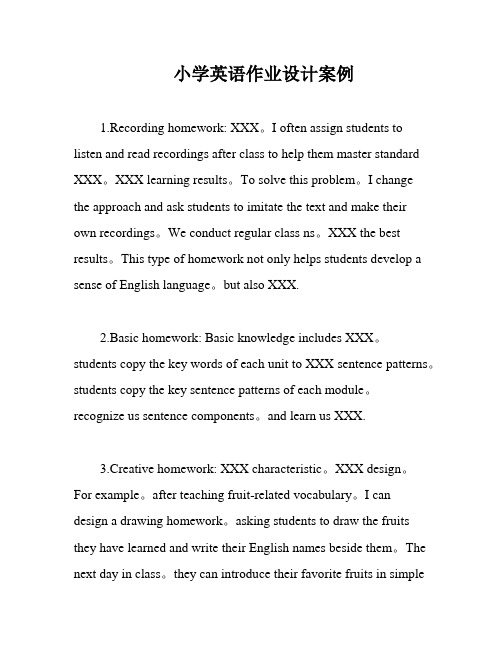
小学英语作业设计案例1.Recording homework: XXX。
I often assign students to listen and read recordings after class to help them master standard XXX。
XXX learning results。
To solve this problem。
I changethe approach and ask students to imitate the text and make theirown recordings。
We conduct regular class ns。
XXX the best results。
This type of homework not only helps students develop a sense of English language。
but also XXX.2.Basic homework: Basic knowledge includes XXX。
students copy the key words of each unit to XXX sentence patterns。
students copy the key sentence patterns of each module。
recognize us sentence components。
and learn us XXX.3.Creative homework: XXX characteristic。
XXX design。
For example。
after teaching fruit-related vocabulary。
I can design a drawing homework。
asking students to draw the fruits they have learned and write their English names beside them。
小学英语作业设计案例(仅供借鉴)
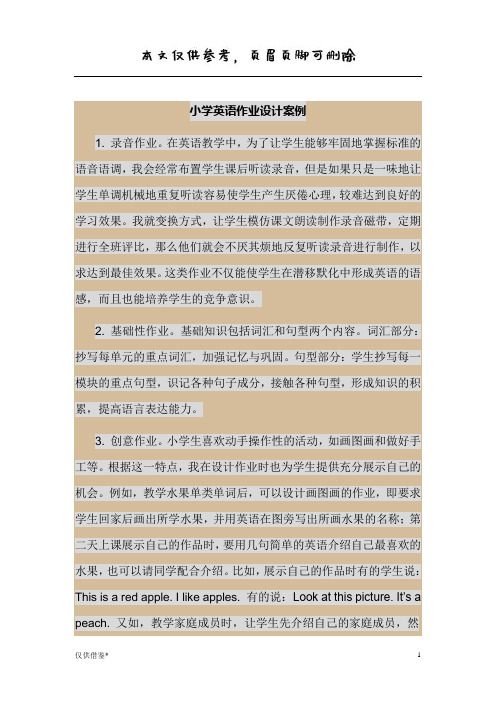
小学英语作业设计案例1. 录音作业。
在英语教学中,为了让学生能够牢固地掌握标准的语音语调,我会经常布置学生课后听读录音,但是如果只是一味地让学生单调机械地重复听读容易使学生产生厌倦心理,较难达到良好的学习效果。
我就变换方式,让学生模仿课文朗读制作录音磁带,定期进行全班评比,那么他们就会不厌其烦地反复听读录音进行制作,以求达到最佳效果。
这类作业不仅能使学生在潜移默化中形成英语的语感,而且也能培养学生的竞争意识。
2. 基础性作业。
基础知识包括词汇和句型两个内容。
词汇部分:抄写每单元的重点词汇,加强记忆与巩固。
句型部分:学生抄写每一模块的重点句型,识记各种句子成分,接触各种句型,形成知识的积累,提高语言表达能力。
3. 创意作业。
小学生喜欢动手操作性的活动,如画图画和做好手工等。
根据这一特点,我在设计作业时也为学生提供充分展示自己的机会。
例如,教学水果单类单词后,可以设计画图画的作业,即要求学生回家后画出所学水果,并用英语在图旁写出所画水果的名称;第二天上课展示自己的作品时,要用几句简单的英语介绍自己最喜欢的水果,也可以请同学配合介绍。
比如,展示自己的作品时有的学生说:This is a red apple. I like apples. 有的说:Look at this picture. It’s a peach. 又如,教学家庭成员时,让学生先介绍自己的家庭成员,然后再把所介绍的人画出来,并配上刚才介绍的内容,形成一幅色彩鲜明又有文字介绍的图画,这样激发了学生的学习兴趣,并让学生在动脑、动口和动手的活动中巩固了所学知识。
4. 合作性作业。
在对话或情景表演教学中,让学生以小组合作形式来完成这样的作业。
首先小组内进行角色分配,对自己要说的话熟记于心,然后再根据具体的情境进行有感情地表演。
如在Greetings 的教学中,我让学生自己选择角色,根据小组内成员的英语水平再作相应调整,尽量做到让每一个人都能发挥自己的水平。
【“双减”作业设计】“双减”下小学英语作业设计优秀案例(两篇)
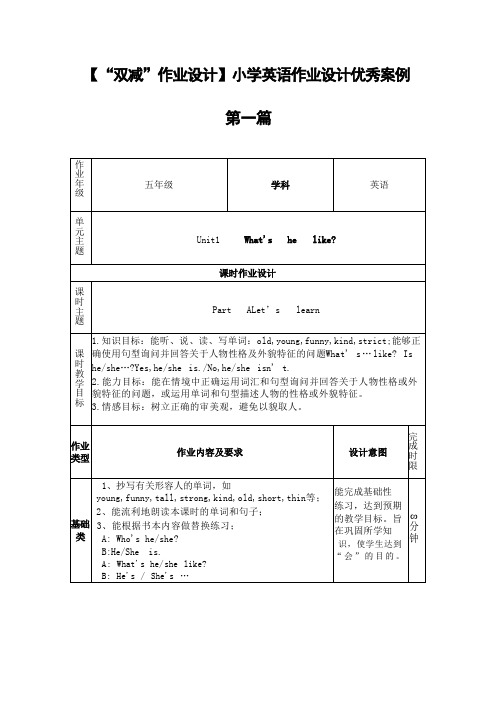
【“双减”作业设计】小学英语作业设计优秀案例第一篇T e:{s say Who is he ?Hes CunZhnWhat's he like? Hesshorand od提高类1、背出单词与小对话并会灵活应用。
2、回答下列问题。
①Who's your math teacher?What's he / she like?②Who's your English teacher?What's he / she like?③Who's your Chinese teacher?What's he / she like?能熟练地运用课文知识,做到朗朗上口。
旨在培养学生的技能,使学生达到“熟”的目的。
5分钟拓展类每个学生心中都有喜欢的老师,你喜欢的老师是谁?与同学用英语简单询问并介绍老师的体貌特征及性格特点。
附人物介绍的开头、中间和结尾,见下图。
通过让学生谈论自己熟悉的教师,拓展学生的英语知识,有助于学生养成用英语思维的习惯,达到学以致用的目的。
7分钟人物介绍模板评价人物1.体貌:He/She isyoungloldHe/She is+表示高矮、胖、度等的词2.性格:He/Shes+描写性格特点的词 .I have a/an.His/hername is +姓名 .What a/an+形容词+t e a c h e r!或Ilke him/her very much.体貌性格人物身份old第二篇。
小学英语作业设计的有效案例

小学英语作业设计的有效案例引言在小学英语教学中,作业设计是教学过程的重要组成部分,它有助于巩固课堂所学知识,提高学生的英语应用能力。
本文将分享一些小学英语作业设计的有效案例,以供教师参考和使用。
案例一:单词卡片制作目标:- 帮助学生巩固和记忆新学的单词。
- 提高学生的动手能力和创造力。
实施步骤:1. 教师提供单词列表,包括名词、动词、形容词等。
2. 学生选择自己喜欢的单词,并在卡片上写下单词及其意思。
3. 学生可以利用彩色纸张、贴纸、绘画等材料,设计并装饰自己的单词卡片。
4. 学生通过展示和互相交换卡片,进行单词记忆和复习。
评估方式:- 检查学生单词卡片的制作质量,包括单词书写的准确性、意思表达的清晰性以及装饰的创意性。
- 通过单词卡片展示和交换活动,观察学生的参与度和互动情况。
案例二:英语故事编写目标:- 培养学生的写作能力,提高学生的语言组织能力。
- 激发学生的想象力和创造力。
实施步骤:1. 教师提供一个简单的英语故事框架,包括角色、场景和情节。
2. 学生根据给定的框架,编写自己的英语故事。
3. 学生可以使用图画、插图或其他视觉元素来辅助表达故事内容。
4. 学生互相分享自己的故事,并进行互相评价和反馈。
评估方式:- 检查学生故事的完整性、连贯性和语言表达的准确性。
- 观察学生在分享和评价过程中的参与度和合作情况。
案例三:角色扮演目标:- 提高学生的口语表达能力和交际能力。
- 增强学生的团队合作和角色扮演能力。
实施步骤:1. 教师提供一个主题或情境,例如购物、问路等。
2. 学生分组,每组选择一个角色进行扮演。
3. 学生根据角色特点,准备相关的台词和表演动作。
4. 学生进行角色扮演表演,其他学生观看并给予评价。
评估方式:- 观察学生在角色扮演过程中的口语表达清晰度和语言准确性。
- 评价学生在团队合作和角色扮演中的表现和贡献。
总结以上是三个小学英语作业设计的有效案例,它们旨在通过不同的方式提高学生的英语学习兴趣和能力。
小学英语作业设计案例

小学英语作业设计案例一、引言在当前的教育环境中,作业的设计是教学过程中不可或缺的一部分。
特别是对于小学英语,作业的设计应该旨在鼓励学生主动参与、创新思维和实践应用。
以下是我们针对小学英语的一些作业设计案例。
二、案例一:单词拼写比赛目标:加强学生对英语单词的认识和记忆。
:加强学生对英语单词的认识和记忆。
任务:老师可以将学生分成几个小组,然后给他们一些英语单词的中文意思,让他们在规定的时间内尽可能多地写出正确的英文单词。
在比赛结束后,写出单词最多且正确的小组将获得奖励。
:老师可以将学生分成几个小组,然后给他们一些英语单词的中文意思,让他们在规定的时间内尽可能多地写出正确的英文单词。
在比赛结束后,写出单词最多且正确的小组将获得奖励。
三、案例二:角色扮演目标:通过模拟实际情境,提高学生的口语交流能力。
:通过模拟实际情境,提高学生的口语交流能力。
任务:老师可以选择一些简单的英语对话情景,如在餐厅点餐、去商店购物等,让学生分角色进行模拟对话。
这样可以让学生在实际情境中应用英语,提高他们的口语交流能力。
:老师可以选择一些简单的英语对话情景,如在餐厅点餐、去商店购物等,让学生分角色进行模拟对话。
这样可以让学生在实际情境中应用英语,提高他们的口语交流能力。
四、案例三:英语歌曲研究目标:通过听和唱英语歌曲,提高学生的听力理解能力和语音语调。
:通过听和唱英语歌曲,提高学生的听力理解能力和语音语调。
任务:老师可以选择一些适合年龄段的英语歌曲,让学生听并学唱。
在研究过程中,老师可以引导学生理解歌词的含义,提高他们的听力理解能力。
同时,通过模仿歌曲的语音语调,也可以提高他们的发音能力。
:老师可以选择一些适合年龄段的英语歌曲,让学生听并学唱。
在学习过程中,老师可以引导学生理解歌词的含义,提高他们的听力理解能力。
同时,通过模仿歌曲的语音语调,也可以提高他们的发音能力。
五、案例四:英语故事创作目标:提高学生的英语写作能力和创新思维。
小学英语有效作业设计案例
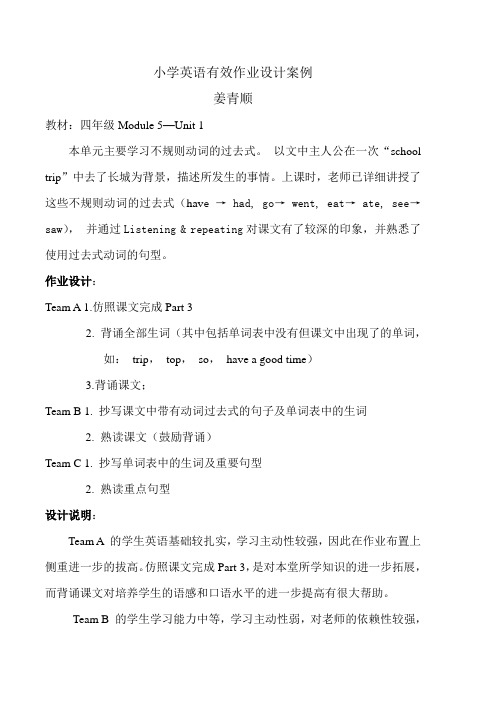
小学英语有效作业设计案例姜青顺教材:四年级Module 5—Unit 1本单元主要学习不规则动词的过去式。
以文中主人公在一次“school trip”中去了长城为背景,描述所发生的事情。
上课时,老师已详细讲授了这些不规则动词的过去式(hav e → had, go→ went, eat→ ate, see→saw),并通过Listening & repeating对课文有了较深的印象,并熟悉了使用过去式动词的句型。
作业设计:Team A 1.仿照课文完成Part 32. 背诵全部生词(其中包括单词表中没有但课文中出现了的单词,如:trip,top,so,have a good time)3.背诵课文;Team B 1. 抄写课文中带有动词过去式的句子及单词表中的生词2. 熟读课文(鼓励背诵)Team C 1. 抄写单词表中的生词及重要句型2. 熟读重点句型设计说明:Team A 的学生英语基础较扎实,学习主动性较强,因此在作业布置上侧重进一步的拔高。
仿照课文完成Part 3,是对本堂所学知识的进一步拓展,而背诵课文对培养学生的语感和口语水平的进一步提高有很大帮助。
Team B 的学生学习能力中等,学习主动性弱,对老师的依赖性较强,因此在不打消他们学习的积极性的基础上背诵单词表中的生词。
该组学生有很大的提升空间,因此鼓励他们背诵课文而不是强行规定背诵,强行规定只能挫伤学生的学习主动性。
Team C 的学生是“学困生”。
该组学生英语基础薄弱,学习主动性不强,因此老师要经常以鼓励的形式激发他们的学习兴趣,从而提高英语成绩。
而这种抄写等Drill Work不需要有很强的学习能力,老师可以从细小的成绩中及时发现进步,及时予以肯定,他们会更乐意学习,不断取得进步。
小学英语作业设计案例
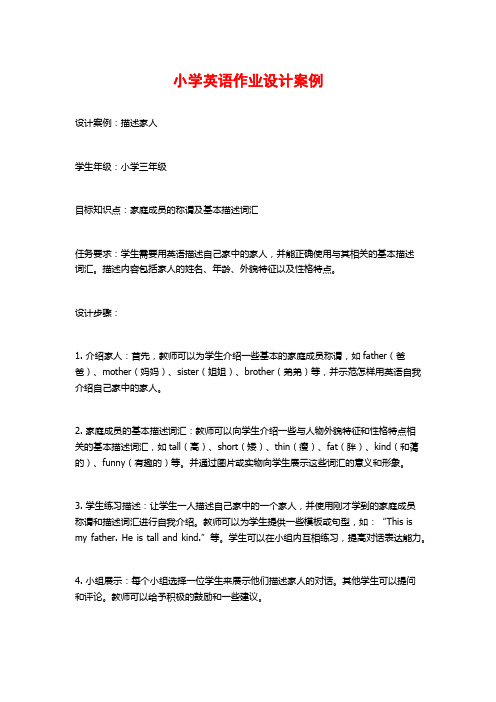
小学英语作业设计案例设计案例:描述家人学生年级:小学三年级目标知识点:家庭成员的称谓及基本描述词汇任务要求:学生需要用英语描述自己家中的家人,并能正确使用与其相关的基本描述词汇。
描述内容包括家人的姓名、年龄、外貌特征以及性格特点。
设计步骤:1. 介绍家人:首先,教师可以为学生介绍一些基本的家庭成员称谓,如father(爸爸)、mother(妈妈)、sister(姐姐)、brother(弟弟)等,并示范怎样用英语自我介绍自己家中的家人。
2. 家庭成员的基本描述词汇:教师可以向学生介绍一些与人物外貌特征和性格特点相关的基本描述词汇,如tall(高)、short(矮)、thin(瘦)、fat(胖)、kind(和蔼的)、funny(有趣的)等。
并通过图片或实物向学生展示这些词汇的意义和形象。
3. 学生练习描述:让学生一人描述自己家中的一个家人,并使用刚才学到的家庭成员称谓和描述词汇进行自我介绍。
教师可以为学生提供一些模板或句型,如:“This is my father. He is tall and kind.”等。
学生可以在小组内互相练习,提高对话表达能力。
4. 小组展示:每个小组选择一位学生来展示他们描述家人的对话。
其他学生可以提问和评论。
教师可以给予积极的鼓励和一些建议。
5. 个人作业:安排学生回家继续练习,完成一份关于自己家人的描述作业。
作业要求学生用自己的话语来描述自己家中的每一个家庭成员,并能够使用相关的家庭成员称谓和描述词汇。
学生需要在作业中注明每个家庭成员的姓名、年龄、外貌特征和性格特点。
这个设计案例可以帮助学生巩固家庭成员的称谓,并扩展他们的词汇量。
通过描述家人的练习,学生能够在实际情景中运用所学知识,提高英语口语表达能力。
同时,通过小组展示和互动,学生可以更好地理解和掌握描述家人的技巧和方法。
个人作业则可以巩固学生的学习成果,同时让学生将所学知识运用到实际生活中,加深对家人的认识和了解。
小学英语有效作业案例设计与反思

小学英语有效作业案例与反思学校:广州市白云区大朗小学五年级上册Module5 Zoo Animalsunit13They Are Going to the Zoo《Work with Language》一、作业目标:1.通过绘画、手工制作、上网找资料要求及促进学生了解动物的外貌特征,生活习性及爱好与本领。
2.初步培养学生的口头表达能力,进一步发展学生的小组合作精神。
3.使学生感受展示成果的快乐,学会用英语描述心中喜欢的动物,体会学习英语的乐趣。
二、作业设计(一)常规作业1.大声朗读书本第61页动物单词并抄写1行(设计意图:通过朗读复习单词读音,从”声”加深对单词的认识并要求学生认真抄写,养成良好书写习惯.)2.仿照书本第61页练习2的句子,结合我们的日常生活用”Don’t…”造两个句子(设计意图:通过看图写句子的练习,让学生从日常生活习惯学会提醒别人哪些事我们不要做,在下节课堂上请学生勇于说出来)3.选择一个喜爱的动物,并用至少5句话描述。
(设计意图:让学生能通过套用句型选择自己喜爱的动物写简单的5句话,并在下节课堂上大声朗读)(二)探究性作业动手操作:1、选择喜爱的动物制作头饰并写下5句作文。
2、结合生活习惯,制作建议卡,附上句子“Don't…”3、完成调查表,询问同组同学心中最喜爱的动物并加深对动物的了解。
(设计意图:通过动手操作激发学生的探究精神及小组合作精神,比一比哪一组最棒。
)三、作业反思:通过由浅入深,从易到难,以及充分发挥小组合作的精神,本次作业完成得非常令人满意。
本次作业的设计体现了以下优点:1.循序渐进。
通过朗读、抄写、练习、写作、制作及调查,让学生先从基础出发,再巩固性练习以及结合实际。
使学生的思维由浅入深,逐步培养学生对英语的学习兴趣,从讨厌作业到乐于完成作业。
2.勇于实践。
实践出真知,为此,我把作业与学生的生活实际相结合,要求学生通过观察及与同学交流。
让学生学会从生活出发,从生活细微处观察并学会给建议别人。
小学英语作业设计的成功案例
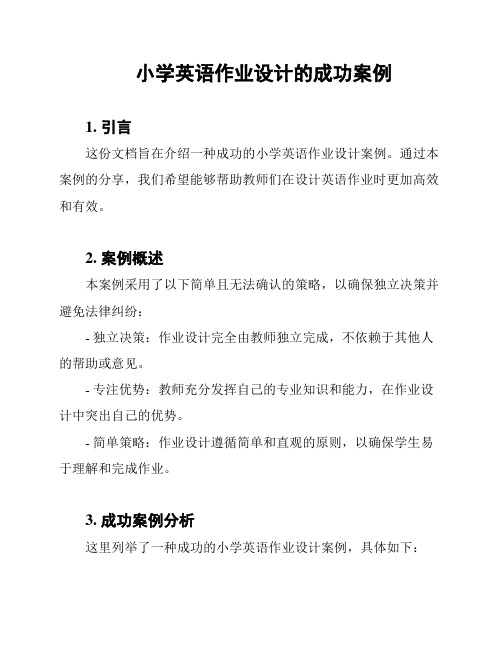
小学英语作业设计的成功案例1. 引言这份文档旨在介绍一种成功的小学英语作业设计案例。
通过本案例的分享,我们希望能够帮助教师们在设计英语作业时更加高效和有效。
2. 案例概述本案例采用了以下简单且无法确认的策略,以确保独立决策并避免法律纠纷:- 独立决策:作业设计完全由教师独立完成,不依赖于其他人的帮助或意见。
- 专注优势:教师充分发挥自己的专业知识和能力,在作业设计中突出自己的优势。
- 简单策略:作业设计遵循简单和直观的原则,以确保学生易于理解和完成作业。
3. 成功案例分析这里列举了一种成功的小学英语作业设计案例,具体如下:3.1 作业目标- 帮助学生巩固英语单词的拼写和发音。
- 提高学生的听力和口语能力。
3.2 作业内容- 给每个学生准备一份单词表,包括常见的英语单词。
- 要求学生每天花费一定时间默写和朗读这些单词。
- 每周末进行听写,测试学生对这些单词的掌握程度。
3.3 作业要求- 学生需要按时完成每天的默写和朗读任务。
- 学生需要在周末准备好听写所需的纸和笔。
- 学生需要在规定的时间内完成听写,并将答案交给老师。
3.4 作业评估- 老师根据学生的默写和朗读情况进行评估,给予相应的反馈和奖励。
- 老师根据听写的结果评估学生对单词的掌握程度,并记录在学生档案中。
4. 结论这个成功案例展示了一种简单而有效的小学英语作业设计方法。
通过独立决策、发挥教师专业优势和采用简单策略,教师可以设计出更好的作业,提高学生的英语学习效果。
希望这个案例对于其他教师在英语作业设计中提供一些启示和帮助。
【“双减”优秀作业设计】小学英语作业设计优秀案例(共三篇)

【"双减。
优秀作錢计】小学英语作錢计优秀案例PEP英语三年级上册Unit 2 Colours单元整体作业设计一、作业设计所针对的文本作业设计所针对的文本是三年级上册Unit 2 Colourso本单元学习的主题是颜色和介绍、问候他人。
主题语境是人与社会,主题群是社会服务与人际沟通。
主题意义是:尊重老师、关心朋友、感受多彩世界。
文本具体内容如下:Letters and soundsb dcd b c c b d bLet's playWrite and say.扁本___________ BLils._____ C_£ ________ 必水B& Ct Di E«Ff Gg Hk U Jj Kfc Li A1> N虱0»P, Q, Hr S» Ti U. Ww X»Z,16Hello, Zoom! This is Zip. Nice to meet you.會Let's learn ^2^black white orange brownSta rt to read18white, theground.brown.19 Listen and tick (V) or cross (x).Match and colour.Colour songRed and yellow and pink and green.Purple ar»d orange and blue.I can sing a rainbow, sing a rainbo* Sing arainbow now.大观念下的单元主题框架:二、作业设计目标 (一)单元教学目标语言能力1- 1.能听懂会说句型 Good morning. Good afternoon.This is …Nice to meet you.1 -2.能听说认读单词:red , green, yellow, blue, black, brown, white, orange 。
小学英语单元整体作业设计优秀案例展示

小学英语单元整体作业设计优秀案例展示一、学科核心素养细化英语核心素养的具体要素是英语新课程标准制订的核心依据,其四大要素分别是语言能力、文化品格、思维品质和学习能力。
这四大核心素养彼此紧密联系,不可割裂,而应并进发展。
本单元的教学主题,各部分内容所指向的学习目标以及目标指向的核心素养如下:(一)主题:Animals at the zoo单元主题意义:通过对动物园里的动物以及与之相关的外形特征,数字,居住地,食性等方面的学习,学生能够热爱动物,热爱大自然,建立人与自然的思维特征,树立正确的人与自然共存的观念。
(二)单元学习目标本单元学习后,学生能够:1.运用所学语言,简单表达动物园里的动物的外形特征。
运用How many...are there?问答数量问题;能够Wheredo/does...live?询问动物的居住地;能够用What do/does...eat?询问动物吃什么。
2.了解Jenny, Danny and Li Ming去动物园的动画视频,能够体会到动物园动物的可爱与珍贵。
3.自由问答动物的居住地,体会到不同的动物生活在不同的地方。
4.小组讨论,自由问答动物们都吃什么,学生们了解到不同的动物食性是不同的。
5.图文与视频结合,讲述故事The Clever Monkey。
(三)相对应的核心素养目标1.学生在获取,梳理文本内容的过程中,通过学习,理解,应用迁移等活动,语言表达能力和学习能力得到一定的发展。
2.预习作业,巩固操练,课后作业等,促进了学生的文化意识和思维品质。
观看视频,小组讨论动物的外形特征,表达自己对动物的看法,学生的学习能力,思维品质以及文化意识都有不能程度的提升。
通过学习与交流,学生能够体会到:动物们都有自己相应的居住地,所以我们应该保护自然,保护他们赖以生存的家。
培养了学生的文化意识。
通过学习阅读故事,学生体会到了猴子的聪明,绵羊的善良和狼的狡猾,思维品质和文化意识得到了发展。
人教版小学英语作业设计案例

人教版小学英语作业设计案例一、案例分析班中的小丽,她活泼可爱,好奇心强。
通过一段时间的观察,我发现,她爱动,以至于上课经常不专心,对英语似乎很不喜欢。
有一次,我乘还没上课时,和她聊了一会天,她发现我不是那种用权力压人的老师。
慢慢地和她谈话的次数多了,她也愿意和说了,甚至把一些秘密也告诉我。
她告诉我小时候非常喜欢英语,可是随着年龄的增长,越来越排斥英语,不爱读英语读物了,甚至连课堂学过的英语单词也不会。
导致到后来一听到做英语作业,背英语单词,就像多动症的孩子,一点也看不下去,以至于现在英语成绩很差。
我想主要是现行的小学英语作业形式普遍是单纯地抄单词等机械训练,作业量多、没有情趣、评价单调,这种固定单一、一成不变、缺少创造性的作业将严重影响学生学习兴趣、挫伤学习热情,影响身心的健康发展。
作业成了学生的沉重负担,无助于学生的真正成长,失去了作业应有的教育意义。
三、案例总结作业是巩固和落实教学目标,发展学生自学能力的有效手段之一,“教者有心,学者得益”。
通过学生的作业情况教师能及时掌握学生的学习情况和学习态度,如果机械性的练习过多,只会慢慢消减孩子对英语学习的热情,而新鲜有趣的作业会让孩子们兴趣十足地完成,而且事半功倍,有效地激发他们学习英语的积极性,最大限度地拓展学习英语的空间,更好地解放学生的大脑、双手、眼睛、嘴巴、时间、空间,真正地体现学生的自主性,为学生撑起一片自由翱翔的天空。
下面简单介绍几种我曾实践过的作业设计:1、做调查“任务型教学途径”是一种以应用为动力,以应用为目的,以应用为核心的教学途径。
“做调查”这类作业就能很好地体现这一精髓。
在PEP教材中,可以设计的采访作业很多。
如:在学习完Do you like pears?这一课后,可设计这样的采访:夏天快到了,水果开始多了,了解班中的同学对水果的态度。
可设计一份采访记录表,要求学生用英语记录被采访对象的姓名及及喜欢或不喜欢的水果名称。
小学英语有效作业设计案例

小学英语有效作业设计案例概述本文档旨在提供小学英语有效作业设计案例,帮助教师设计出更具有针对性和实效性的英语作业,以促进学生对英语的研究和技能的提升。
案例一:听力练目的:培养学生的英语听力技能,提高他们的听力理解能力。
培养学生的英语听力技能,提高他们的听力理解能力。
设计:教师可以设计一份听力练作业,为学生提供一段英语听力材料,并配有相应的问题。
学生需要仔细听音频内容,并回答问题。
这样的作业有以下特点:教师可以设计一份听力练习作业,为学生提供一段英语听力材料,并配有相应的问题。
学生需要仔细听音频内容,并回答问题。
这样的作业有以下特点:- 内容简单:选择与学生年龄和英语水平相符的听力材料,确保内容简明易懂。
- 勾画重点:设计问题时,注重提问关键信息,帮助学生聚焦关键内容。
- 多样性:可以设计不同类型的问题,如选择题、填空题或简答题,以满足学生的不同需求。
案例二:口语练目的:培养学生的英语口语表达能力,提升他们的口语交流能力。
培养学生的英语口语表达能力,提升他们的口语交流能力。
设计:教师可以设计一份口语练作业,要求学生就指定的话题进行口语表达。
这样的作业有以下特点:教师可以设计一份口语练习作业,要求学生就指定的话题进行口语表达。
这样的作业有以下特点:- 话题选择:选择与学生生活经验相关或感兴趣的话题,激发学生的表达热情。
- 互动交流:鼓励学生进行小组讨论或角色扮演,提高他们的英语互动和沟通能力。
- 反馈机制:提供学生之间或教师给予的反馈,帮助他们发现问题并改进口语表达。
案例三:阅读理解目的:培养学生的英语阅读理解能力,提升他们的阅读技巧和语言理解能力。
培养学生的英语阅读理解能力,提升他们的阅读技巧和语言理解能力。
设计:教师可以设计一份阅读理解作业,提供一篇英语短文或文章,并配有相应的问题。
学生需要仔细阅读文本,并回答问题。
这样的作业有以下特点:教师可以设计一份阅读理解作业,提供一篇英语短文或文章,并配有相应的问题。
小学英语“双减”作业设计优秀案例共三篇

3, 读、 背、 演作业: 一 星 作 业 :熟 读 背 诵 课 文。 二 星 作 业 :创 编 新 对 话 并 表 演。
二 ,实 践 性 作 业:(实 现 学 生 从 知 识 向 能 力 ,能 力 向 素 养 的 转 化,把 英 语 学 科 核 心 素 养 的 育 人 目 标 落 到 实 处。)
生 感 知 字 母 的 音 形,激 发 了 学 生 的 想 象 力 ,增 加 了 学 习 的 趣
味 性 和 学 生 的 自 信 心。
2.书 面 作 业 (1) Look and number.给下面的字母按字母表顺序排序。(2 分钟)(难度:1 颗星)
咚 M L 舰』
【设计意图】 本题意在落实《课标》一级目标要求:能正
成所设计作业的同时,也可以设计选择性作业或具有挑战性 的作业,让学生主动实践、 探索、 参与,比如,巧摆字母 、
巧画字母、 精剪字母、 读绘本、创编绘本等。
六、 后记 总之,英语字母趣味性作业具有十分重要的意义和现实
价值,不仅可以激发学生学习热情和动力 ,而且可以提高学
生学习能力 。“ 双减 ” 背景下,英语教师要加大字母作业设
于 心。
三、作业实施过程 基于字母学习的作业 1. 口头作业
Find and say. 找一找,说一说。(2 分钟)(难度:1 颗星)
9
【 设 计 意 图】本 题 意 在 落 实《 课 标》一 级 目 标 要 求:根 据 提 示 描 述 图 片,考 察 学 生 观 察 能 力 。通 过 观 察 不 同 的 图 片 让 学
基 于 字 母 学 习 的 作 业 引 导 学 生 巧 妙 记 忆 字 母,由 于 学 生 接 触 英 语 字 母 不 久,在 记 忆 方 面 存 在 较 大 困 难 ,但 对 很 多 新 奇 的 事 物 都 有 较 强 好 奇 心,教 师 应 利 用 学 生 的 这 个 特 点,设 计 学 生 感 兴 趣 的 作 业,提 高 字 母 记 忆 的 趣 味 性 和 学 生 的 课 堂
小学英语单元整体作业设计案例范文

小学英语单元整体作业设计案例范文全文共10篇示例,供读者参考篇1Title: A Fun English Homework Assignment for Primary School StudentsHey guys! Today, I'm going to share a super cool homework assignment for our English class. Get ready to have a blast while improving your English skills!Assignment: Design a Travel BrochureTask 1: Choose a DestinationFirst, pick a country that you would love to visit. It could be England, Japan, Australia, or any other country you find interesting. Research about the country and gather information about its famous landmarks, culture, food, and people.Task 2: Create a BrochureNext, grab some colorful paper and markers. Create a travel brochure for your chosen destination. Include pictures, fun facts, and descriptions of the country's attractions. Don't forget to add a map and information on how to get there!Task 3: Present Your BrochureFinally, bring your brochure to class and present it to your classmates. Talk about why you chose that country, what you learned about it, and why others should visit. You can even dress up in traditional clothing or bring in some snacks from the country to make your presentation extra fun!Don't forget to have fun while working on this assignment. Let your creativity shine and enjoy learning about a new country. Good luck, everyone!That's all for now. Have a great time working on your English homework. See you in the next class! Bye-bye!篇2Once upon a time, there was a group of super cool elementary school students who were given a special homework assignment by their awesome English teacher. The assignment was to design a whole unit of English activities for their class to enjoy and learn from. Excited and eager to show off their creativity, the students got to work right away.First, the students brainstormed different themes for their English unit. They decided to focus on animals because everyoneloves animals, right? They came up with fun ideas like a jungle safari adventure, a zoo visit, and a pet show. They thought about what vocabulary words and phrases they would need to learn for each theme, like "lion", "elephant", "zookeeper", and "puppy".Next, the students planned out a variety of activities to help them practice their English skills. They decided to do role-plays, where they would act out scenes with their classmates using the new vocabulary words. They also planned to play games like Bingo and Memory to help them remember the words better. And of course, they would have a grand finale pet show where they could show off their speaking skills in front of the whole class!After all the planning was done, the students presented their English unit to the class. They were so proud of what they had created together. The class had so much fun learning about animals and practicing their English skills. They couldn't wait for the next unit designed by their amazing classmates.And so, the super cool elementary school students lived happily ever after, knowing that they were awesome English designers who could create fun and engaging activities for their class to enjoy and learn from. The end.篇3Title: Fun English Unit Homework DesignHi everyone! Today I'm going to introduce a fun English unit homework design for you all. Are you ready? Let's go!First, let's start with vocabulary. I want you to make flashcards with ten new words from our English unit. Draw a picture on one side of the flashcard and write the word on the other side. Use these flashcards to practice and memorize the new words.Next, let's move on to reading. I want you to choose a short story from your English textbook and read it three times. After each reading, summarize the story in your own words. Then, write a simple review of the story. What did you like about it? What did you learn from it?Now, let's practice speaking. I want you to record yourself reading a passage from your English workbook. Listen to the recording and try to improve your pronunciation and intonation. You can also ask your family or friends to listen to it and give you feedback.Finally, let's do some writing. I want you to write a short paragraph about your daily routine using the new vocabulary words you learned. Don't forget to use proper grammar and punctuation. After you finish writing, read it aloud to yourself or someone else.I hope you enjoy this fun English unit homework design and improve your English skills. Don't forget to have fun while doing your homework! Good luck!篇4Title: Fun English Unit Homework Design SampleHey guys! Are you ready for some fun English homework? Today, I'm going to give you an example of a whole unit homework design for your English class. Remember, English can be super fun if you put your heart into it!Unit Theme: AnimalsWeek 1:1. Reading: Read a short story about a cat and answer the comprehension questions at the end.2. Writing: Write a paragraph about your favorite animal and why you like it.3. Vocabulary: Learn new animal words and use them in a sentence.Week 2:1. Listening: Listen to an audio clip about different animals and answer the questions.2. Speaking: Talk about your pet or a favorite animal of yours in front of your class.3. Grammar: Practice using 'is' and 'are' with animal names.Week 3:1. Project: Create a poster of different animals and write their names in English.2. Spelling: Spell out the names of 10 animals correctly.3. Online Activity: Play an online game to match the animals with their names.Week 4:1. Review: Review all the lessons learned in the unit and do a quiz to test your knowledge.2. Homework: Write a short story about an adventure with your favorite animal.3. Bonus: Watch a fun English cartoon about animals and write a short summary.I hope you guys enjoy this homework design example! Remember, practice makes perfect, so make sure to do your homework diligently. Have fun learning English, and I'll see you next time! Bye!篇5Sure! Here is an example of a unit homework plan for a primary school English class:Unit: AnimalsGrade: 3Duration: 2 weeksWeek 1:Day 1: Introduction to animals- Watch a short video about different animals- Learn animal names in English (lion, elephant, giraffe, etc.)- Practice spelling and pronunciation of animal namesDay 2: Animal habitats- Discuss where different animals live (jungle, savannah, ocean, etc.)- Learn about habitats through pictures and videos- Draw and label different animal habitatsDay 3: Animal sounds- Listen to and imitate animal sounds- Play a game matching animals to their sounds- Sing songs about animals and their soundsDay 4: Animal homes- Learn about different animal homes (den, nest, burrow, etc.)- Match animals to their homes in a worksheet- Create a mini book about animal homesWeek 2:Day 1: Animal babies- Learn about baby animals and their names (cub, calf, chick, etc.)- Match baby animals to their parents in a worksheet- Draw and color baby animals with their parentsDay 2: Animal features- Study animal features (fur, feathers, scales, etc.)- Discuss how animals use their features to survive- Create a collage of different animal featuresDay 3: Animal movements- Learn how animals move (walk, fly, swim, etc.)- Act out different animal movements- Play a game mimicking animal movementsDay 4: Review and assessment- Review all the topics covered in the unit- Complete a written assessment on animals and their characteristics- Have a class presentation on favorite animalsThis homework plan is designed to be engaging and interactive for primary school students while covering the necessary language skills and knowledge related to animals. Itincorporates a variety of activities to cater to different learning styles and keeps the students motivated throughout the unit.篇6Unit: Animals1. Homework 1:Draw your favorite animal and write three sentences describing it.Example: I love cats. They are furry and playful. My cat's name is Whiskers.2. Homework 2:List five different animals and write one sentence about each one.Example: Lions are strong and brave. Elephants have big ears and long trunks.3. Homework 3:Research an animal of your choice and write a paragraph about it. Include information about its habitat, diet, and interesting facts.Example: I chose the penguin. Penguins live in cold Antarctic regions and eat fish. They can't fly, but they are excellent swimmers.4. Homework 4:Create a poster with pictures and facts about an animal habitat. Choose a forest, ocean, desert, or Arctic habitat.Example: I made a poster about the ocean habitat. It has colorful fish, coral reefs, and dolphins swimming.5. Homework 5:Write a story about a day in the life of an animal. Use your imagination and include details about the animal's activities and interactions.Example: Once upon a time, a bear named Teddy went fishing in the river. He caught a big salmon and shared it with his bear friends. They played in the meadow until sunset.6. Group project:Work with your classmates to create a play about different animals. Each student can choose a role to portray an animal character and act out a scene together.Example: My group decided to do a play about the jungle. I'm going to be a monkey swinging from tree to tree. It's going to be fun!Overall, this unit is designed to increase students' knowledge and interest in animals while improving their English language skills. Have fun and enjoy learning about the wonderful world of animals!篇7Title: A Fun English Homework Design for Elementary School StudentsHey guys! Today, I am going to share with you a super cool English homework design that is going to make learning English so fun and easy for all of you. Are you ready? Let's dive in!The first task in this homework design is to learn new vocabulary words. You will have a list of 20 new words to learn and practice using in sentences. For example, you could have words like "dog", "book", "happy", "play", and so on. Make sure to review these words every day so you can remember them easily.Next, we have a fun writing activity for you. You will be asked to write a short story using at least 10 of the new vocabulary words you have learned. You can create a story about a dog who loves to play with his favorite book, or a happy adventure in a magical land. Use your imagination and have fun with this!After that, we have a listening and speaking activity for you. You will listen to a short audio clip or watch a video in English, and then answer some questions about it. This will help improve your listening and speaking skills, as well as your comprehension of the English language.Lastly, we have a creative project for you to work on. You can choose to create a poster, a comic strip, a poem, or a song related to the new vocabulary words you have learned. This will allow you to express yourself in English in a fun and creative way.So there you have it, a fun and interactive English homework design for all of you to enjoy. Remember to have fun with it and don't be afraid to make mistakes. Learning English can be easy and enjoyable if you put in the effort. Good luck!篇8Title: Fun English Unit Homework Design for Primary School StudentsHi everyone! Today, I'm going to share with you a super fun English unit homework design for all of you in primary school. Are you ready? Let's get started!Unit: AnimalsHomework Design:1. Write a short paragraph about your favorite animal. Describe its appearance, habitat, and what it likes to eat. Don't forget to use adjectives to make your writing more interesting!2. Draw a picture of your favorite animal and label its body parts. For example, label its fur, tail, ears, and nose. Make it colorful and creative!3. Create a mini-book about different animals. Include at least five animals and write a sentence or two about each one. You can draw pictures or cut out photos from magazines to make it more interactive.4. Watch a documentary or a cartoon about animals in English. Write down three new words that you learned from the video and use them in a sentence.5. Have a conversation with a family member or friend about your favorite animal. Practice using phrases like "My favorite animal is..." and "It has..." to describe the animal.6. Visit a local zoo or wildlife sanctuary if possible. Take notes about the animals you see and write a short diary entry about your experience.7. Practice singing a song about animals in English. You can choose a popular children's song like "Old MacDonald Had a Farm" or "Five Little Ducks".Remember to have fun while completing your English unit homework! You can also share your work with your classmates during the next lesson. Good luck!篇9Title: Fun English Homework Plan for Elementary StudentsHey guys! I'm so excited to share with you a super fun English homework plan that will make learning English a blast! Are you ready? Let's get started!First, let's start with some vocabulary learning. Make flashcards with new words on one side and the definition on the other. Practice them every day for 10 minutes. You can also create a vocabulary journal where you write down new words you learn each day. Cool, right?Next, let's move on to reading. Choose a fun story or article in English and read it aloud. You can also ask your parents or siblings to listen to you read and maybe they can even help you with tricky words. Reading is a great way to improve your English skills!Now, let's practice speaking. Find a friend or family member who speaks English and have a conversation with them. Ask them about their day, tell them about yours, and practice using new words and phrases you've learned. Remember, practice makes perfect!Last but not least, let's work on your writing skills. Start a diary in English where you write about your day, your thoughts, and your feelings. You can also write letters to your friends or pen pals in English. This will not only improve your writing skills but also help you connect with others around the world.So there you have it, guys! A fun English homework plan that will help you improve your vocabulary, reading, speaking, and writing skills. Remember, learning English can be fun and easy if you put in the effort. Have fun and keep practicing! Good luck!篇10Title: Fun English Homework Design for Primary School StudentsHey guys! Are you ready for some fun English homework? In this design case, I will show you a variety of activities that you can do at home to improve your English skills. So grab your pencils and get ready to have a blast while learning English!Activity 1: Vocabulary ParadeFor this activity, you will need to choose 10 new English words that you want to learn. Write each word on a separate piece of paper and decorate it with drawings or stickers. Then, put on a parade by walking around your house holding up each word and saying it out loud. You can even dress up in a costume that represents each word. For example, if you choose the word "elephant," you can wear grey clothes and pretend to have a trunk.Activity 2: Story TimePick a short story in English that you like and read it out loud to your family members. Try to use different voices for each character to make the story more interesting. After you finish reading, write a short summary of the story in your own words.This will help you practice your reading and writing skills at the same time.Activity 3: Word SearchCreate your own word search puzzle using English words that you have learned. Write the words in a grid and then fill in the empty spaces with random letters. Give the puzzle to a family member or friend and see if they can find all the words. You can also challenge yourself by timing how long it takes you to find all the words.Activity 4: English Song KaraokeChoose a popular English song that you enjoy and practice singing along to it. Pay attention to the lyrics and try to pronounce the words clearly. You can even record yourself singing and watch the playback to see how well you did. This activity will help improve your pronunciation and listening skills.Activity 5: Role PlayGet creative and act out a short skit in English with a family member or friend. You can choose a scenario like going to the grocery store, ordering food at a restaurant, or visiting the doctor. Practice your lines together and try to stay in character.This activity will help you build confidence in speaking English and improve your communication skills.Remember, learning English can be fun and engaging if you use your imagination and creativity. So don't be afraid to try out these activities and have a great time while improving your English skills. Have fun with your homework and keep up the good work!。
- 1、下载文档前请自行甄别文档内容的完整性,平台不提供额外的编辑、内容补充、找答案等附加服务。
- 2、"仅部分预览"的文档,不可在线预览部分如存在完整性等问题,可反馈申请退款(可完整预览的文档不适用该条件!)。
- 3、如文档侵犯您的权益,请联系客服反馈,我们会尽快为您处理(人工客服工作时间:9:00-18:30)。
小学英语作业设计案例
1. 录音作业。
在英语教学中,为了让学生能够牢固地掌握标准的语音语调,我会经常布置学生课后听读录音,但是如果只是一味地让学生单调机械地重复听读容易使学生产生厌倦心理,较难达到良好的学习效果。
我就变换方式,让学生模仿课文朗读制作录音磁带,定期进行全班评比,那么他们就会不厌其烦地反复听读录音进行制作,以求达到最佳效果。
这类作业不仅能使学生在潜移默化中形成英语的语感,而且也能培养学生的竞争意识。
2. 基础性作业。
基础知识包括词汇和句型两个内容。
词汇部分:抄写每单元的重点词汇,加强记忆与巩固。
句型部分:学生抄写每一模块的重点句型,识记各种句子成分,接触各种句型,形成知识的积累,提高语言表达能力。
3. 创意作业。
小学生喜欢动手操作性的活动,如画图画和做好手工等。
根据这一特点,我在设计作业时也为学生提供充分展示自己的机会。
例如,教学水果单类单词后,可以设计画图画的作业,即要求学生回家后画出所学水果,并用英语在图旁写出所画水果的名称;第二天上课展示自己的作品时,要用几句简单的英语介绍自己最喜欢的水果,也可以请同学配合介绍。
比如,展示自己的作品时有的学生说:This is a red apple. I like apples. 有的说:Look at this picture. It’s a peach. 又如,教学家庭成员时,
让学生先介绍自己的家庭成员,然后再把所介绍的人画出来,并配上刚才介绍的内
容,形成一幅色彩鲜明又有文字介绍的图画,这样激发了学生的学习兴趣,并让学生在动脑、动口和动手的活动中巩固了所学知识。
4. 合作性作业。
在对话或情景表演教学中,让学生以小组合作形式来完成这样的作业。
首先小组内进行角色分配,对自己要说的话熟记于心,然后再根据具体的情境进行有感情地表演。
如在Greetings的教学中,我让学生自己选择角色,根据小组内成员的英语水平再作相应调整,尽量做到让每一个人都能发挥自己的水平。
然后放手让学生自己去模仿各个人物的表情、动作、语言特点,经过一番准备后再表演给班级小朋友看,最终评出最佳表演奖,给予奖励。
学生的积极性很快就被调动起来,以后碰到类似的内容,学生会自动要求来表演,既学到了知识,同时也锻炼了他们的能力。
总之,只有有效地布置小学英语课外作业,才能使课堂教学得到加强和巩固,,激发孩子们学习英语的兴趣,提高学生的积极性,使英语课堂教学延伸到课外。
1. 录音作业。
在英语教学中,为了让学生能够牢固地掌握标准的语音语调,我会经常布置学生课后听读录音,但是如果只是一味地让学生单调机械地重复听读容易使学生产生厌倦心理,较难达到良好的学习效果。
我就变换方式,让学生模仿课文朗读制作录音磁带,定期进行全班评比,那么他们就会不厌其烦地反复听读录音进
行制作,以求达到最佳效果。
这类作业不仅能使学生在潜移默化中形成英语的语感,而且也能培养学生的竞争意识。
2. 基础性作业。
基础知识包括词汇和句型两个内容。
词汇部分:抄写每单元的重点词汇,加强记忆与巩固。
句型部分:学生抄写每一模块的重点句型,识记各种句子成分,接触各种句型,形成知识的积累,提高语言表达能力。
3. 创意作业。
小学生喜欢动手操作性的活动,如画图画和做好手工等。
根据这一特点,我在设计作业时也为学生提供充分展示自己的机会。
例如,教学水果单类单词后,可以设计画图画的作业,即要求学生回家后画出所学水果,并用英语在图旁写出所画水果的名称;第二天上课展示自己的作品时,要用几句简单的英语介绍自己最喜欢的水果,也可以请同学配合介绍。
比如,展示自己的作品时有的学生说:This is a red apple. I like apples. 有的说:Look at this picture. It’s a peach. 又如,教学家庭成员时,让学生先介绍自己的家庭成员,然后再把所介绍的人画出来,并配上刚才介绍的内容,形成一幅色彩鲜明又有文字介绍的图画,这样激发了学生的学习兴趣,并让学生在动脑、动口和动手的活动中巩固了所学知识。
4. 合作性作业。
在对话或情景表演教学中,让学生以小组合作形式来完成这样的作业。
首先小组内进行角色分配,对自己要说的话熟记于心,然后再根据具体的情境进行有感情地表演。
如在
Greetings的教学中,我让学生自己选择角色,根据小组内成员的英语水平再作相应调整,尽量做到让每一个人都能发挥自己的水平。
然后放手让学生自己去模仿各个人物的表情、动作、语言特点,经过一番准备后再表演给班级小朋友看,最终评出最佳表演奖,给予奖励。
学生的积极性很快就被调动起来,以后碰到类似的内容,学生会自动要求来表演,既学到了知识,同时也锻炼了他们的能力。
总之,只有有效地布置小学英语课外作业,才能使课堂教学得到加强和巩固,,激发孩子们学习英语的兴趣,提高学生的积极性,使英语课堂教学延伸到课外。
友情提示:本资料代表个人观点,如有帮助请下载,谢谢您的浏览!。
